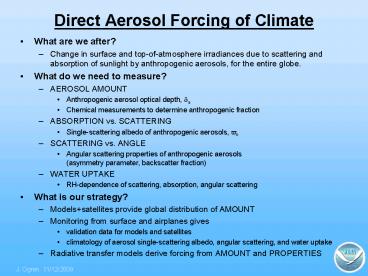Direct Aerosol Forcing of Climate - PowerPoint PPT Presentation
1 / 8
Title:
Direct Aerosol Forcing of Climate
Description:
Change in surface and top-of-atmosphere irradiances ... Anthropogenic aerosol optical depth, a Chemical measurements to determine ... and overpass nearby ... – PowerPoint PPT presentation
Number of Views:45
Avg rating:3.0/5.0
Title: Direct Aerosol Forcing of Climate
1
Direct Aerosol Forcing of Climate
- What are we after?
- Change in surface and top-of-atmosphere
irradiances due to scattering and absorption of
sunlight by anthropogenic aerosols, for the
entire globe. - What do we need to measure?
- AEROSOL AMOUNT
- Anthropogenic aerosol optical depth, ?a
- Chemical measurements to determine anthropogenic
fraction - ABSORPTION vs. SCATTERING
- Single-scattering albedo of anthropogenic
aerosols, vo - SCATTERING vs. ANGLE
- Angular scattering properties of anthropogenic
aerosols(asymmetry parameter, backscatter
fraction) - WATER UPTAKE
- RH-dependence of scattering, absorption, angular
scattering - What is our strategy?
- Modelssatellites provide global distribution of
AMOUNT - Monitoring from surface and airplanes gives
- validation data for models and satellites
- climatology of aerosol single-scattering albedo,
angular scattering, and water uptake - Radiative transfer models derive forcing from
AMOUNT and PROPERTIES
2
Observations of Direct Climate Forcing
- Global mapping of anthropogenic aerosol optical
depth (AOD) by satellites and models - Regional climatology of radiative forcing
efficiency (RFE) from in-situ measurements - Direct Climate Forcing (W m-2)DCF AOD ff
faf RFEa
In-situ profiling needed
ff fine mode fraction of AOD faf
anthropogenic fraction of fine mode AOD
3
- DOE/ARM funding for Oklahoma project, gt600
flights since 3/2000- NOAA funding to sample
over another continental U.S. site with an
enhanced payload. Start flying June 2006.
In-situ Aerosol Profiling Aircraft
- Information on aerosol properties aloft is
scarce, satellites and surface stations give
limited data. - Light airplanes can be used to monitor vertical
profiles of key aerosol properties at modest
cost. - Objectives
- obtain aerosol climatology aloft
- determine relevance of surface climatology
- Summary Cessna 172 or Cessna 206, profiles to 4
km asl, aerosol light scattering and absorption,
automated operation.
4
Notes Results are for 324 profiles from March,
2000 March, 2003 over the DOE/ARM site.
Aerosol radiative properties reported at 550 nm
wavelength, RHlt40, and particle diameter below 1
mm.
Seasonal Variation of Average Aerosol Profiles
over Oklahoma Aerosol Amount
5
Notes Results are for 324 profiles from March,
2000 March, 2003 over the DOE/ARM site.
Aerosol radiative properties reported at 550 nm
wavelength, RHlt40, and particle diameter below 1
mm.
Seasonal Variation of AverageAerosol Profiles
over Oklahoma
6
Vertical Profile of RFE over Oklahoma
surface
DOE/ARM funded research March 25, 2000 - April
17, 2006, 616 flights
7
NOAA Airborne Aerosol Observatory
- Objective Obtain a climatology of aerosol
properties aloft for testing models and satellite
retrievals - Stair-step flight patterns from surface to 15k
(occasionally 18k), 2-3 flights per week - Underfly satellites when possible (A-Train)
- requires clear sky and overpass nearby
- Most profiles in vicinity of CMDL aerosol
monitoring station near Bondville, IL - possibly relocate to Trinidad Head, CA for
springtime maximum in transport from Asia - Status installation on Turbo Cessna 206 in May
2006, flights beginning June 2006
- Aerosol chemistry
- major ions, water-soluble organic carbon
- eventually add trace elements, gravimetric mass
- Aerosol size distribution
- Aerosol optics
- light scattering, absorption, hygroscopic growth
- Gases
- continuous O3, carbon-cycle flasks
8
Variations in Radiative Forcing Efficiency
Only one site with vertical profiles































